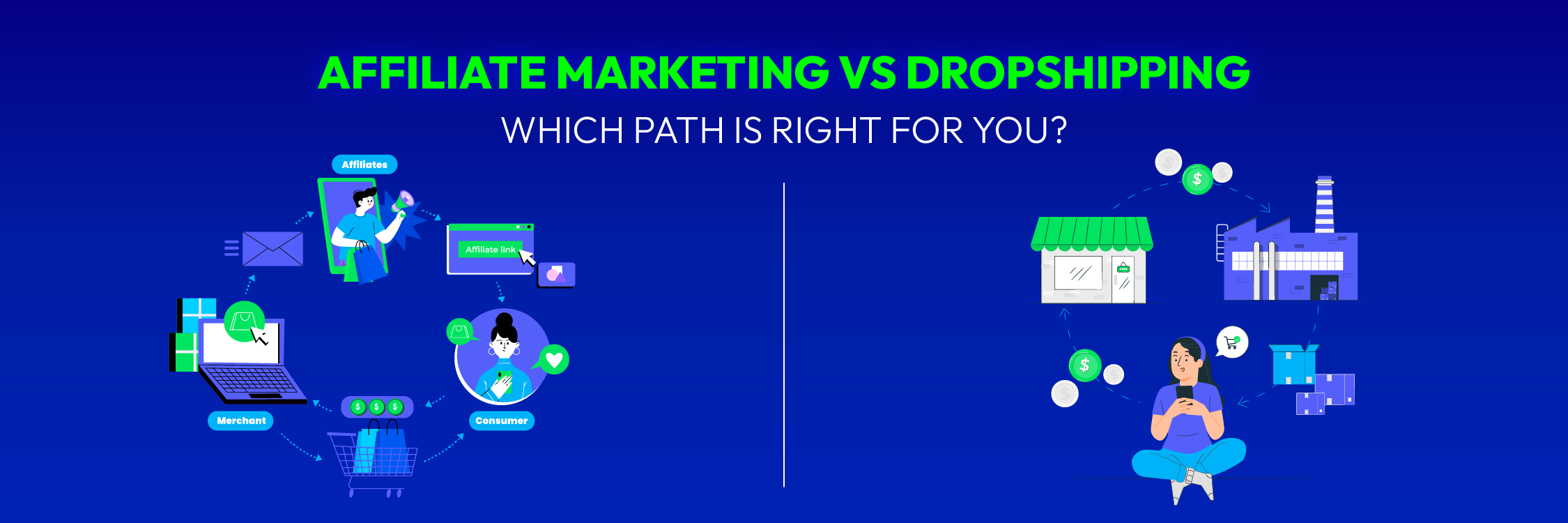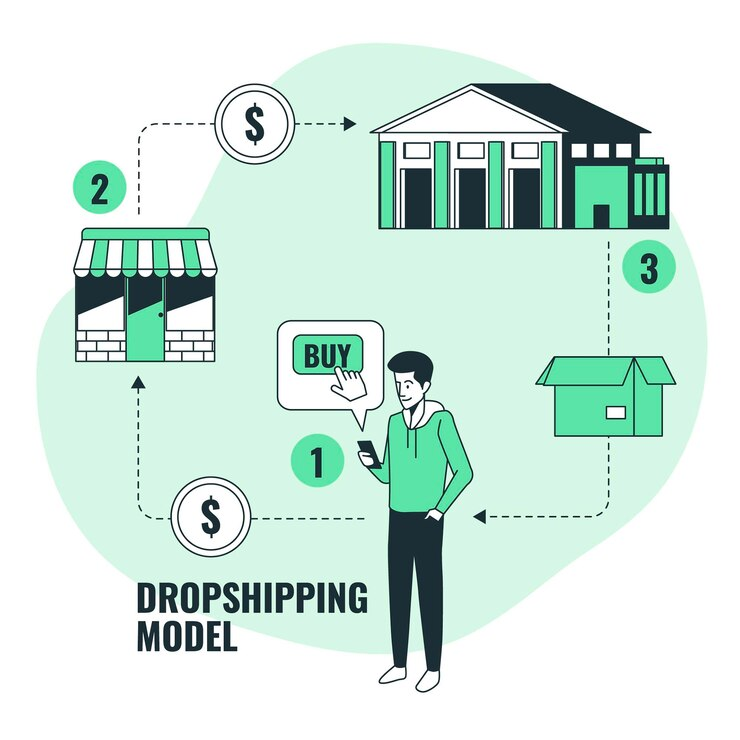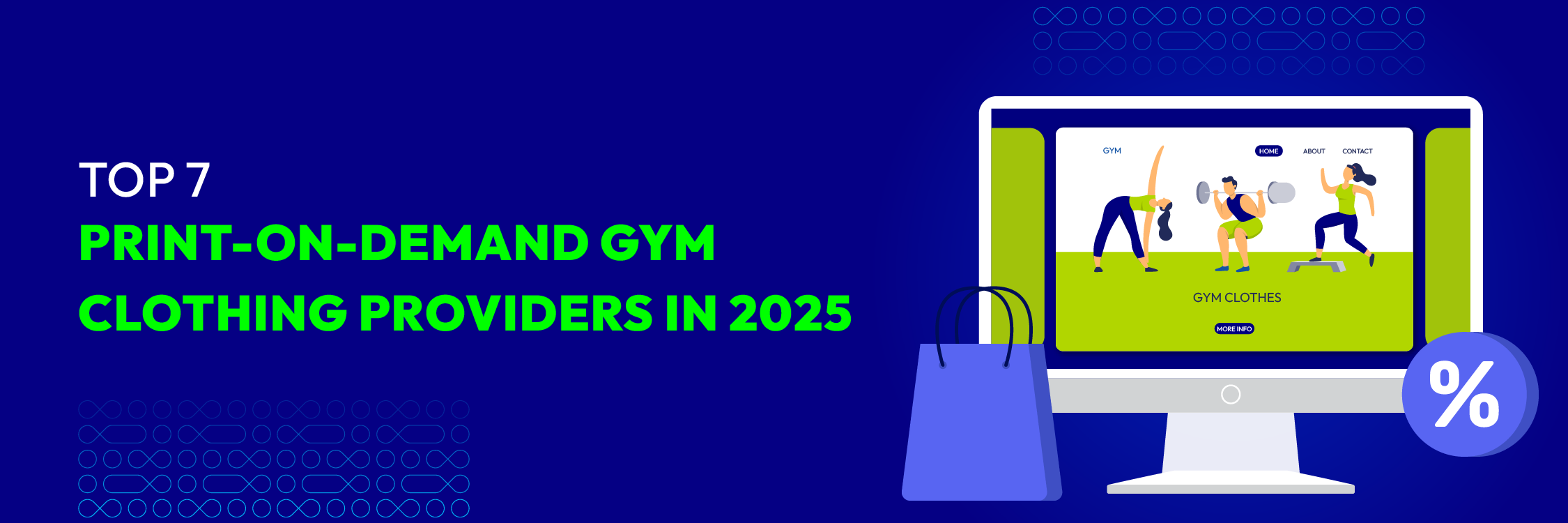Affiliate Marketing vs Dropshipping: Which Path Is Right for You?
Summer Nguyen | 12-18-2024

The potential for entrepreneurs to leverage online platforms and create successful businesses has never been greater in the digital age. Two popular business models that have gained significant traction are affiliate marketing and dropshipping. These models offer individuals the opportunity to start their own online ventures with minimal upfront costs and the potential for substantial profits. However, it is crucial to understand the differences between these two approaches in order to make an informed decision about which path to pursue.
Affiliate Marketing vs. Dropshipping Overview
Affiliate marketing involves promoting other people’s products or services, and earning a commission for each sale made through your referral. As an affiliate marketer, you act as a middleman between the customer and the merchant. Your main role is to generate leads and drive traffic to the merchant’s website through various marketing channels, such as content marketing, social media, or email marketing. You receive a commission upon a sale based on the conditions established.
Dropshipping, on the other hand, is a business model where you act as a middleman between the customer and the supplier. Instead of purchasing and stocking inventory upfront, you list products on your online store and forward customer orders to the supplier. The supplier then ships the products directly to the customer. In this model, you are responsible for marketing, customer service, and managing the online store, while the supplier takes care of inventory and order fulfillment.
Understanding the Concept of Affiliate Marketing
Affiliate marketing is essentially a performance-based marketing strategy. As an affiliate marketer, you earn a commission when your promotional efforts result in a sale. This model allows you to focus on marketing and driving traffic to the merchant’s website, without having to worry about keeping track of inventory or order fulfillment. It is a low-risk business model, as you do not have to invest in product development or inventory.

Pros of Affiliate Marketing
- Low upfront costs: Affiliate marketing requires minimal investment, as you do not have to create or store products.
- Passive income potential: Once you have established your marketing channels, you can earn commissions on an ongoing basis with minimal additional effort.
- Wide range of product options: Affiliate marketing allows you to choose from a diverse range of products and niches, aligning your business with your interests and passions.
Cons of Affiliate Marketing
- Limited control over sales process: As an affiliate marketer, you rely on the merchant’s website to convert leads into sales, limiting your influence on factors such as pricing, customer service, and product quality.
- Variable commission rates: Commission rates in affiliate marketing can vary significantly, and it may take time to build a substantial income stream.
- Dependence on external factors: Your success as an affiliate marketer is dependent on factors such as search engine rankings, algorithm changes, and market trends.
Skills Needed for Affiliate Marketing
- Skills for Affiliate Marketing:
- Content Creation: Crafting engaging and persuasive content that captures your audience’s attention and drives them to take action through your affiliate links.
- Copywriting: The ability to write compelling copy that persuades users to click and make a purchase.
- SEO: Understanding the nuances of SEO to improve your website’s visibility in search engines and boost organic traffic.
- Social Media Management: Leveraging social platforms to build your online presence, connect with your audience, and promote affiliate products effectively.
- Email Marketing: Proficiency in email marketing tools to build and engage your subscriber list, enhancing your chances of conversions.
- Relationship Building: Networking within your niche to establish collaborations, seek mentorship, and create opportunities for growth.
Explore: 5 Best Affiliate Management Software Solutions for Smart Marketers
Exploring the World of Dropshipping
Dropshipping has gained significant popularity in recent years due to its low barrier to entry and potential for high-profit margins. In this business model, you are essentially acting as a middleman between the customer and the supplier. Your primary focus is on marketing and customer service, while the supplier takes care of inventory management and order fulfillment.

Pros of Dropshipping
- Minimal upfront costs: Dropshipping eliminates the need for inventory investment, making it an affordable option for entrepreneurs.
- Flexibility and scalability: You can easily add or remove products from your online store based on market demand, allowing for quick adaptation and growth.
- Wide product range: Dropshipping enables you to offer a without the need for physical storage space.
Cons of Dropshipping
- Intense competition: Due to the low cost to entry, dropshipping has become a very competitive market that needs strong branding and marketing to stand out.
- Reliance on suppliers: Your business’s reputation and customer satisfaction are dependent on the performance of your suppliers in inventory management and order fulfillment.
- Lower profit margins: Since you are acting as a middleman, your profit margins in dropshipping tend to be lower compared to other business models.
Skills Needed for Dropshipping
- Website Design: Creating an attractive, user-friendly online store or using e-commerce platforms dropshipping that align with your niche and branding.
- Marketing Acumen: Proficiency in marketing strategies, including social media, advertising, SEO, and email marketing, to drive traffic to your store.
- Customer Service: Ensuring top-notch customer service to handle inquiries, complaints, and issues professionally and efficiently.
- Inventory Management: Monitoring stock levels, avoiding overselling, and keeping product information up to date.
Key Differences Between Affiliate Marketing and Dropshipping
Profit
In terms of profit potential, both affiliate marketing and dropshipping offer opportunities for success. However, the profit margins can vary significantly between the two models. Affiliates in affiliate marketing receive commissions based on a predetermined share of the sales made as a result of their referrals. This commission rate is typically fixed and remains consistent across different sales, ranging from 5% to 30% depending on the product or service.
On the other hand, in the dropshipping model, your earnings are the profit margin, which is the difference between a product’s manufacturing cost and the price at which you sell it. Here, you have the flexibility to set the selling price according to your strategy and market demand, allowing for a more adaptable pricing approach.
Both affiliate marketing and dropshipping offer their own unique advantages in terms of financial risk. Dropshipping, for instance, is considered a low-risk business model due to its “pay-as-you-go” nature. You only procure the products from suppliers after you’ve received payment from customers, reducing the financial risk associated with holding inventory.
On the other hand, affiliate marketing has lower costs to start up. Here, you’re not required to purchase any products upfront, minimizing the financial investment needed to get started. This lower barrier to entry allows individuals to enter the affiliate marketing arena with limited upfront capital. It’s a good choice for people who are on a tight budget.
Risks
Affiliate Marketing Risks
In affiliate marketing, your primary risk centers around the merchant’s capability to convert the leads you provide into actual sales. This hinges on several factors:
- Merchant Performance: The effectiveness of the merchant’s website and sales process is important. If their site is not user-friendly, doesn’t offer a seamless shopping experience, or lacks reliable customer service, it can directly affect your earnings.
- Product Quality: The quality and appeal of the products or services you’re promoting can impact conversion rates. If customers are dissatisfied with the product’s quality or relevance to their needs, it could lead to a lower conversion rate and commissions.
- Customer Experience: If customers have a negative experience with the merchant after the sale, it can lead to refunds, chargebacks, or decreased trust in your recommendations.
- Market Volatility: The economy and market fluctuations can pose a threat. Consumer preferences, external events, or changes in demand for specific products can influence the success of your affiliate marketing efforts.
Dropshipping Risks
In dropshipping, risk primarily centers around supplier performance and operational aspects:
- Supplier Reliability: The most important thing is that your providers are trustworthy and reliable. Issues like delayed shipments, inconsistent product quality, or problems with inventory management can directly affect your business’s reputation and customer satisfaction.
- Inventory Management: Ensuring that your suppliers maintain accurate inventory levels is crucial. Overselling or running out of stock can lead to order cancellations and customer frustration. -Product Quality Control: As you don’t physically handle the products, verifying and maintaining product quality can be challenging. Poor-quality products can result in a higher rate of returns and dissatisfied customers. -Shipping and Delivery: Timely and reliable shipping is essential. Shipping delays or mishaps can lead to negative customer reviews and damage your business’s reputation. -Competitive Pricing: Keeping your business profitable while keeping a competitive price point for your products can be difficult to do. Overpricing can lead to fewer sales, while underpricing can hurt your earnings.
Time Commitment
Your time investment for affiliate marketing and drop shipping may be different depending on your situation. In affiliate marketing, your primary focus is on generating leads and driving traffic to the merchant’s website. Once you have set up your marketing channels and established a steady flow of traffic, the ongoing time commitment can be relatively low.
Affiliate marketing requires a lot of work at the beginning, but as your business grows, you’ll need to put in less effort. Once you have built up a large online following, you will find that you don’t have to be as involved all the time. One of the most exciting aspects of affiliate marketing is the snowball effect. This is when your current content and following keep bringing in passive income over time as your reach grows.
Dropshipping involves managing your online store, including customer service, inventory updates, and order fulfillment. This can require more time and effort, especially as your business grows and you expand your product offerings. But dropshipping has a special edge over affiliate marketing. If you choose the right area, you’ll be able to sell products that people are actively looking for. This connection with market demand can make it more likely that your dropshipping business will be successful and make money.
Required Technical Expertise
Both affiliate marketing and dropshipping require a certain level of technical expertise, but in different areas. In affiliate marketing, you need to have a good understanding of digital marketing strategies, such as content creation, search engine optimization, and social media marketing. Basic website management skills are also beneficial.
In dropshipping, while marketing skills are important, you also need to be proficient in setting up and managing an online store, including product listings, payment gateways, and order management systems. Additionally, basic knowledge of inventory management and logistics can be beneficial in dropshipping.
Scalability
Scalability is an important factor to consider when choosing between affiliate marketing and dropshipping. Both models offer potential for growth, but in different ways. Scalability in affiliate marketing primarily involves increasing the volume of traffic to your marketing channels and your reach. This can be done through various strategies, such as content creation, social media advertising, or email marketing.
In dropshipping, scalability is achieved by partnering with multiple suppliers, expanding your product offerings, and optimizing your online store to handle increased traffic and orders.
Here’s a comprehensive table highlighting the differences between affiliate marketing and dropshipping:
| **Affiliate Marketing** | **Dropshipping** | |
|---|---|---|
| Business Model | Promote others' products or services and earn commissions for referrals. | Sell products under your brand name without holding inventory. |
| Ownership of Products | Promote other brands' products or services. | You list and sell products under your own brand. |
| Inventory Management | No need for inventory management. | No need for inventory management. |
| Shipping | No responsibility for shipping. | Suppliers handle product shipping. |
| Customer Service | No direct involvement in customer service. | Handle customer inquiries and issues. |
| Upfront Costs | Typically low upfront costs; mainly website or platform expenses. | Higher upfront costs for website development, marketing, and tools. |
| Control Over Products | No control over product quality, features, or pricing. | Control over product selection, pricing, and branding. |
| Income Potential | Passive income; income potential depends on affiliate program performance. | Active income; income potential depends on marketing efforts and sales. |
| Time Commitment | Requires less ongoing management; focus on content creation and promotion. | Requires ongoing management of the online store, customer support, and marketing. |
| Risk | Low financial risk; risks associated with affiliate program policies and performance. | Supplier and customer satisfaction risks; quality and fulfillment issues. |
| Niche Selection | Can choose from a wide range of niches and products. | Can choose from a wide range of products and niches. |
| Brand Building | Focus on content and authority building; not building a unique brand. | Opportunity to build and customize your own brand. |
| Scalability | Potential for scalability through content and audience growth. | Potential for scalability by adding more products and marketing efforts. |
Affiliate Marketing vs. Dropshipping: How to Start?
How to Start Affiliate Marketing
-
Choose Niche and Product: Carefully select a niche that resonates with your interests and expertise. Choose products or services that are relevant to your niche and have attractive affiliate programs.
-
Enroll in Affiliate Program: Join reputable affiliate programs or networks that offer the products or services you want to promote. Research their terms and commission structures.
-
Create Website or Blog: Establish a website or blog where you can create and publish valuable content related to your niche. This content will serve as a platform to promote your affiliate products or services.
-
Create Content: Develop high-quality content, including blog posts, reviews, videos, or social media posts, that provides value to your audience. Incorporate your affiliate links strategically within your content.
-
Generate Traffic: Implement various methods, such as SEO optimization, social media marketing, email marketing, or paid advertising, to drive targeted traffic to your website or blog.
-
Promote: Use persuasive copywriting techniques to convince your audience to click on your affiliate links and take the desired actions, such as making a purchase or signing up for a service.
Explore: 10 Excellent Affiliate Marketing Courses to Learn
How to Start Dropshipping
-
Select Niche and Do Product Research: Begin by carefully choosing a niche and selecting products that have both high demand and a healthy profit margin. Conduct thorough market research to identify trends and opportunities.
-
Find a Supplier: Find reliable suppliers who offer quality products, fast shipping, and responsive customer service. Establish strong relationships with these suppliers to ensure smooth operations.
-
Set up Online Store: Create an online store to showcase your chosen products. E-commerce platforms like Shopify, WooCommerce, or BigCommerce can simplify this process.
-
Customize Store: Customize your store to align with your niche and branding. Pay attention to design, product categorization, and user experience.
-
Develop Marketing Strategies: Develop a comprehensive marketing strategy that includes social media marketing, content marketing, search engine optimization (SEO), email marketing, and paid advertising. Your goal is to drive targeted traffic to your store.
-
Process Order and Support Customer: As orders come in, forward them to your suppliers for fulfillment services. Be prepared to handle customer inquiries, complaints, returns, and any issues that may come up.
Explore: Shopify Dropshipping: A Comprehensive Guide on How to Dropship for 2023
Factors to Consider When Choosing Between Affiliate Marketing and Dropshipping
When deciding between affiliate marketing and dropshipping, you should consider various factors that align with your goals, interests, and resources. Here are some key factors to consider:
Budget
Examine your financial resources carefully and determine which model fits inside your budget limits. Affiliate marketing generally demands fewer upfront costs since it doesn’t necessitate the investment in inventory or the management of product fulfillment. On the other hand, dropshipping may involves expenses such as website development, marketing campaigns, and tools for customer service and order management.
Time commitment
Think about how much time you can actually spend on your business. Your available time can significantly influence your choice between affiliate marketing and dropshipping. Affiliate marketing often proves to be less time-intensive as it doesn’t require the day-to-day management of inventory or the handling of order fulfillment.
In contrast, dropshipping may demand a more substantial time commitment for tasks such as product sourcing, addressing customer inquiries, and managing logistics. It’s crucial to choose a model that corresponds with your available time and level of commitment.
Skills
Delve into an assessment of your existing skills and expertise. Your background and proficiency can significantly sway your decision. If you possess a strong foundation in digital marketing, content creation, and online promotion, affiliate marketing may feel like a natural fit.
Conversely, If you have prior e-commerce experience, online store management, or product sourcing, dropshipping may align more seamlessly with your skill set.
Risk tolerance
Contemplate your level of risk tolerance and conduct a thorough evaluation of the potential risks associated with each business model. Affiliate marketing typically entails lower financial risk since you don’t need to invest in inventory, and your income relies on commissions generated through successful referrals.
Conversely, dropshipping, while generally characterized by lower upfront costs, comes with its own risks. These risks may include supplier reliability, product quality, shipping times, and the paramount task of ensuring customer satisfaction. You should assess your level of comfort with these potential issues and develop risk-mitigation solutions.
Do dropshipping and affiliate marketing have anything in common?
There are indeed some similarities between affiliate marketing and dropshipping, primarily because they are both online business models. Here are some similarities:
- Online Business: Both affiliate marketing and dropshipping are conducted primarily online. They leverage websites, digital marketing, and e-commerce platforms to reach customers.
- Low Barrier to Entry: Both models typically have lower barriers to entry compared to traditional brick-and-mortar businesses. You can start either with relatively low upfront costs.
- No Physical Inventory: In both affiliate marketing and dropshipping, you don’t need to maintain physical inventory. In affiliate marketing, you promote other people’s products, and in dropshipping, you don’t stock products yourself; they are shipped directly from suppliers.
- Affiliate Programs: Some dropshipping businesses offer affiliate programs, allowing you to combine both models. You can promote the dropshipping store’s products as an affiliate and earn commissions on sales.
Which Path to Entrepreneurial Success Is Right for You?
Ultimately, the choice between affiliate marketing and dropshipping depends on your individual circumstances and goals. Both models offer potential for entrepreneurial success, but they differ in terms of profit potential, risk, time commitment, technical expertise required, and scalability. Consider your passion, budget, time availability, skills, and risk tolerance when making your decision.
If you enjoy digital marketing, content creation, and the idea of promoting products or services you believe in, affiliate marketing may be a suitable choice. It offers the potential for passive income and allows you to align your business with your interests and passions. On the other hand, if you have a knack for e-commerce, enjoy managing an online store, and want more control over the sales process, dropshipping may be the right path for you. It offers flexibility, scalability, and the potential for higher profit margins.
Making the Right Choice for Your Entrepreneurial Journey
In conclusion, both affiliate marketing and dropshipping offer unique opportunities for entrepreneurial success in the online marketplace. By understanding the concept, pros and cons, key differences, and factors to consider, you can make an informed decision about which path is right for you. Consider your passion, budget, time availability, skills, and risk tolerance to determine whether affiliate marketing or dropshipping aligns better with your goals and aspirations. Remember, there is no one-size-fits-all answer, and what works for one entrepreneur may not work for another. Choose the path that resonates with you and embark on your entrepreneurial journey with confidence.






